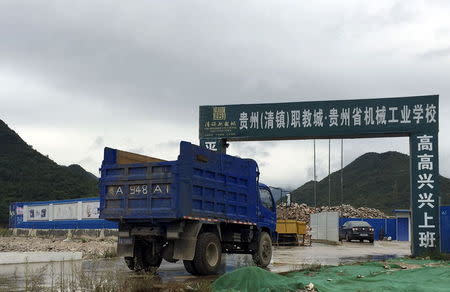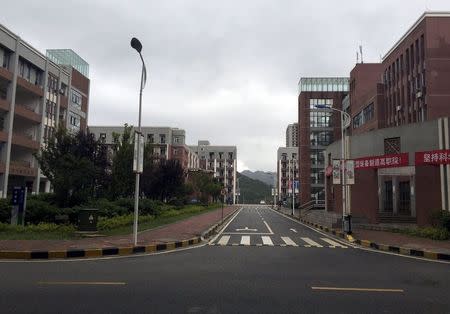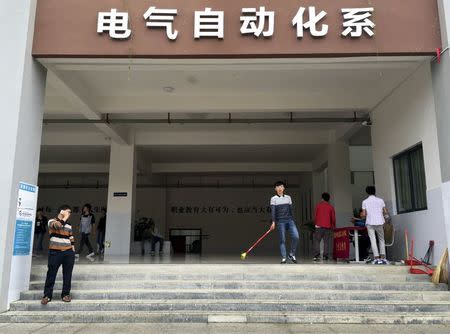China's latest building binge: the education factory
By Alexandra Harney GUIYANG, China (Reuters) - Three decades ago, Chinese cities began turning rural land into industrial parks to attract foreign investors. Today, a new kind of project is blooming in China's countryside: the vocational education park. Cities around China are carving out tracts of land for school parks - dubbed "education factories" - designed to train hundreds of thousands of students. Fuelling their drive are generous government subsidies and targets to increase the number of skilled workers, part of Beijing's push to redirect China's economy away from its investment-led past toward a more innovative, high-tech future. But the expansion comes even as many existing vocational schools are struggling to live up to their promise. "You can build as much as you want, but unless you get good teachers, good curriculum and a system that assesses and rewards high performing schools with more resources, it's just going to be a waste of money," says Scott Rozelle, co-director of the Rural Education Action Program at Stanford University and the author of many papers on vocational education in China. There is no question China needs to raise skill levels. Wayne Zhang, who runs a home decor products factory in northeastern China, says that finding skilled workers - in order to increase capacity or make more complex products - is increasingly hard. Of the 100 such staff he set out to hire last year, he has only been able to find 60. As of 2010, just 24 percent of China's workforce had attended at least some upper secondary school, compared with an OECD average of 74 percent, according to a study published by the Freeman Spogli Institute for International Studies at Stanford University in February. As the labor force shrinks and ages, China also needs to coax more productivity out of each worker. Worker training could help avoid the so-called "middle-income trap" and, in theory, narrow a widening income gap that threatens social stability. OUT OF STEP Lanzhou, capital of central Gansu province, reportedly expects to attract more than 30 schools and 150,000 students to its vocational school park opening in 2017. Ganzhou, in southern Jiangxi province, has been reported to be building a vocational school district which hopes to have at least 10 vocational schools and more than 100,000 students when it opens in 2018. Yunnan, Shandong and Hunan provinces all have vocational school parks. And yet, many Chinese vocational schools already struggle to attract students. Vocational schools, almost all state-run, are usually high schools, although China is pushing to create more vocational universities. But vocational education lacks the prestige of conventional high school. Many teachers have never worked in the industries they are preparing students to join. One study of computing schools found that only 10 percent of teachers had actually worked in the sector. And too often, their critics say, the courses and teaching methods vocational schools offer are out of step with the demands of the economy. Yu Zhongwen, former head of two vocational schools and the vice chairman of the Chinese Society of Vocational and Technical Education, blames a historic lack of government funding compared with the subsidies for traditional education and insufficient corporate involvement in the vocational education system. The Ministry of Education declined a request for comment, saying only that "relevant documents were still being researched and drafted". EDUCATION FACTORY TOWN In a rural area of Guiyang, the capital city of southwestern Guizhou province, tree-covered hills are being razed to make room for the Qingzhen Vocational Education City. Seventeen schools have already agreed to be part of the zone, including agricultural engineering, transportation, construction and automotive schools. The zone has capacity for 35 schools and 300,000 students. At the Guizhou Machinery Industry School, where enrolment is expected to increase from about 7,000 students this year to 10,000 next year, vice president Xu Guoqing says that grouping schools together in a new district will help dispel parents' concerns about the quality of vocational education and lessen overlap in course offerings. State subsidies sweeten the deal. All of the students at Guizhou Machinery are on full scholarships funded by the provincial government. Because they come from poor areas, more than 80 percent of students receive a 2,000 yuan ($315) annual living expenses stipend from the central government. Students said they appreciated the schools' focus on practical skills, rather than the theory taught in conventional high school or university. "Going to class feels like going to work in a factory," said Wu Wei, a student at the construction school. Indeed, one of the criticisms of China's vocational schools is that rather than educating their students, some have simply shipped them off to work at factories as interns under conditions that violate Chinese labor law. Guizhou Machinery Industry School's Xu says that what matters in vocational education is not how big a school is, but how it is run. The stakes are rising for China's vocational schools. Says Xu: "If we run things the old way, we'll be left behind." (Reporting By Alexandra Harney; Additional reporting by Shanghai newsroom; Editing by Alex Richardson)




